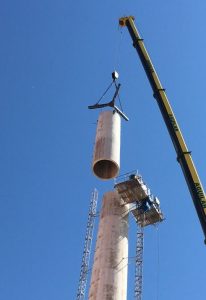Decommissioning of the José Cabrera power plant enters the home straight

GDES, through temporary consortium UTE Monlain, has successfully dismantled the ventilation stack of the José Cabrera nuclear power plant (better known as “Zorita”).
The José Cabrera nuclear power plant will enter the final stage of decommissioning once radiological dismantling and building decontamination have been completed. The final stage will be a conventional demolition of the facility and building structures (including the reactor building).
According to Enresa, owner of the plant since 2010, 86% of the decommissioning project has already been executed.
With the recent removal of the ventilation stack by GDES, through UTE Monlain, the external appearance of the plant has begun to change.
The dismantling of the ventilation stack of the José Cabrera nuclear power plant was carried out successfully and within the established time frame, Enresa has confirmed.
 The stack, made of reinforced concrete, was 60 metres tall and stood on foundations four-and-a-half metres deep. It was cut into 12 large pieces, which were lowered to the ground to be categorised, managed and cut into smaller units.
The stack, made of reinforced concrete, was 60 metres tall and stood on foundations four-and-a-half metres deep. It was cut into 12 large pieces, which were lowered to the ground to be categorised, managed and cut into smaller units.
José Cabrera nuclear power plant was the first to be built in Spain. Construction began in July 1965 and lasted three years. Commercial operation of the plant began in August 1969 and ceased in May 2006, after 38 years of operation, producing 35.53 billion kWh and preventing the emission of more than 32 million tons of CO2 into the atmosphere.
In 2012, the decommissioning of the plant arrived at one of the most crucial moments of the entire project: the opening of the reactor vessel lid and segmentation of its internal components. It was the first time that a decommissioning task of this nature had been undertaken in Spain. This project was also participated by UTE Monalin (GDES – Moncobra), providing support services to Westinghouse; the owner of the plant, Enresa, has endorsed the successful outcome of the operation.